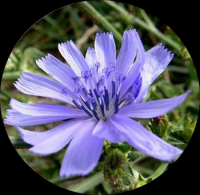Genetic and physical mapping of the S-locus in chicory (Asteraceae)
In collaboration with:
| Dr. Marie-Christine Quillet and Theo Hendriks UMR 8198, CNRS-Université de Lille,Sciences et Technologies Unité Evo-Eco-Paléo (Evolution, Ecologie et Paléontologie) Equipe évolution et écologie - thème génome et reproduction Batiment SN2, Cité Scientifique F-59655 Villeneuve d'Ascq |
|
Abstract
Numerous hermaphrodite plant species have developed self-incompatibility (SI) mechanisms to prevent selfing and crossing between inbred genotypes. SI is caused by molecular mechanisms which involve the rejection of the self-pollen by the stigma or style cells of the plant. Genetics studies showed the existence of two major type of SI: gametophytic SI (GSI) and sporophytic SI (SSI). In species with GSI, the pollen phenotype is determined only by the haploïd genome of the pollen; in SSI systems, the pollen behaviour is dependant of the genotype of the plant which produced the pollen.
SSI has been identified in a few plant families, like Brassicaceae, Asteraceae or Convolvulaceae. In these families, SSI is determined by a multi-allelic complex locus named the S-locus. So far, the pollen and stigma determinants of SSI have been identified only in Brassica. However, molecular studies showed that the genes involved in the SI response in Convolvulaceae and Asteraceae, though not yet identified, are different from those in Brassica. These results strongly suggest that different molecular mechanisms of SSI have evolved independently. The knowledge of the different mechanisms underlying the SI response is important to understand the molecular basis of cell to cell interactions in plants.
Chicory ( Cichorium intybus L.) belongs to the Asteraceae family, and SSI is widespread in wild populations and different cultivar groups (e.g. 'root' chicories). Besides the gain in fundamental knowledge, the identification of genes determining SSI in Asteraceae is of great interest for chicory breeding programs developed in the north of France. In fact, the presence of SSI hampers the selection of highly self-compatible genotypes as progenitors of stable and high-potential hybrid varieties.
We created an intra-specific progeny from a cross between two 'root' chicories, and the compatibility phenotypes of about 300 plants of the progeny are being determined, using tester plants. This progeny is also used to generate a genetic map of chicory and, the S-locus was assigned to one end of one of the 9 linkage groups (2n=18 in chicory).
The objectives of the thesis are to create a high density map around the S-locus and to perform physical mapping of this region based on the genetic mapping results, and the availability of a chicory BAC ( Bacterial Artificial Chromosome) genomic library. The final goal will be the positional cloning of male and female determinants of SSI.
CNRGV's involvement
BAC Libraries construction
Macroarray production and screening
CNRGV's responsible : Sonia Vautrin
Publication related to the project:

